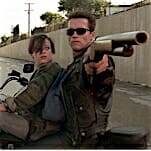How Self-Driving Technology Can Shape Our Highways

Besides picking up where Sandra Bullock’s Crash left off, self-driving cars are populating roadways as much as imaginations. But research on how autonomous vehicles will affect the future is, at this point, largely speculative. Driving behaviors vary greatly depending upon regions, and it’s hard to predict how various factors will influence each other.
One constant in self-driving cars, however, is the knowledge that platooning—linking vehicles in close proximity to each other as they drive down the highway—can positively impact, and drastically change, transportation infrastructure. By creating an optimal amount of space between vehicles, platooning saves on gasoline intake, reduces commute times and creates major safety advantages. Here are five ways that platoons could shape transportation.
Safer and Roomier Highways
Platoons are not only one of the most effective ways to reduce gas consumption and commute times, but also free up considerable space on highways. “A typical freeway lane carries 2,000 vehicles an hour at capacity,” said Dr. Randolph Hall, vice president of research and Professor of Industrial and Systems Engineering at USC. Because platoons reduce space between vehicles, they “could increase that [ratio] to 3,000 or 4,000.” That, in turn, could reduce traffic congestion and delays on highways.
Platooning also reduces accidents due to their closer driving distances. “The basic reason being,” said Dr. Hall, “that if you’re traveling very close and something goes wrong, you’re traveling at such a velocity that the consequences of the collision would not be great.”
A Labor Industry Revolution
An M.I.T. study on platooning recently found that deploying platoons of trucks at regular intervals leads to more efficient and sustainable approach to delivery schedules. What this means, practically speaking, is that convoys of trucks—and not just delivery trucks, but trash trucks, postal service trucks and other commercial vehicles—might one day proceed en masse down our highways as gracefully and routinely as a choreographed ballet.
Dr. Hall pointed out that a major concern with this system is fewer manual labor jobs. But because onboarding commercial platooning will occur gradually, it provides a buffer for economic impact.
Man versus Machine Highways
Onboarding platooning technology takes time. Dr. Hall predicted at least a 15-year adoption curve for it to replace current delivery systems. In the meantime, he described a “mixed fleet” scenario, where traffic contains manual and automated vehicles alike. Mixed fleets could—for a while at least—turn highways into a showdown of “man versus machine.” Because self driving cars are less aggressive than human drivers, they are more likely to be cut off and slowed down. On the flip side, platoons of vehicles—with mammoth delivery trucks especially—could dominate the highway, giving other drivers no choice but to follow their lead.
Platoons as Mass Transit Substitutes
-

-

-

-

-

-

-

-

-

-

-

-

-

-

-

-

-

-

-

-

-

-

-

-

-

-

-

-

-

-

-

-

-

-

-

-

-

-

-

-

 Photo by Alan Nakkash/
Photo by Alan Nakkash/






































